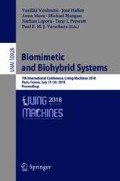Abstract
This paper presents the design of a novel adjustably damped hip and ankle joint using braided pneumatic actuators. These joints provide a wide range of motion and exhibit the same change in stiffness as flexion increases that human joints exhibit, which should also increase bipedal stability, adaptability, and controllability. The theoretical behaviors of the joint make them desirable for use in mobile robotics and should provide a lightweight yet mechanically strong connection that is resistant to unexpected perturbations and catastrophic failure. The joints also bridge the gap between completely soft robotics and completely rigid robotics.
Access this chapter
Tax calculation will be finalised at checkout
Purchases are for personal use only
References
Pratt, G.A., Williamson, M.M., Dillworth, P., Pratt, J., Wright, A.: Stiffness isn’t everything. In: Khatib, O., Salisbury, J.K. (eds.) Experimental Robotics IV, pp. 253–262. Springer, Heidelberg (1997). https://doi.org/10.1007/BFb0035216
Collins, S.H., Ruina, A.: A bipedal walking robot with efficient and human-like gait. In: Proceedings of the 2005 IEEE International Conference on Robotics and Automation, pp. 1983–1988 (2005)
Pratt, G.A.: Low impedance walking robots. Integr. Comp. Biol. 42, 174–181 (2002)
Kim, B.-H.: Work analysis of compliant leg mechanisms for bipedal walking robots. Int. J. Adv. Robot. Syst. 10(9), 334 (2013)
Iida, F., Minekawa, Y., Rummel, J., Seyfarth, A.: Toward a human-like biped robot with compliant legs. Robot. Auton. Syst. 57, 139–144 (2009)
Zhou, X., Bi, S.: A survey of bio-inspired compliant legged robot designs. Bioinspir. Biomim. 7, 041001 (2012)
Standring, S.: Gray’s Anatomy. Elsevier (2015)
Levangie, P.K., Norkin, C.C.: Joint Structure and Function: A Comprehensive Analysis, 5th edn. F. A. Davis Company, Philadelphia (2011)
Hewitt, J., Guilak, F., Glisson, R., Vail, T.P.: Regional material properties of the human hip joint capsule ligaments. J. Orthop. Res. 19, 359–364 (2001)
van Arkel, R.J., Amis, A.A., Cobb, J.P., Jeffers, J.R.T.: The capsular ligaments provide more hip rotational restraint than the acetabular labrum and the ligamentum teres: an experimental study. Bone Jt. J. 97-B, 484–491 (2015)
Mansour, J.M.: Biomechanics of cartilage. In: Biomechanical Principles (2013)
Halonen, K.S., Mononen, M.E., Jurvelin, J.S., Töyräs, J., Kłodowski, A., Kulmala, J.-P., Korhonen, R.K.: Importance of patella, quadriceps forces, and depthwise cartilage structure on knee joint motion and cartilage response during gait. J. Biomech. Eng. 138, 071002-1–071002-11 (2016)
Pelvis and Hip - CT Scan. https://www.embodi3d.com/files/file/11745-pelvis-and-hip-ct-scan/
Kazemi, S.M., Qoreishy, M., Keipourfard, A., Sajjadi, M.M., Shokraneh, S.: Effects of hip geometry on fracture patterns of proximal femur. Arch. Bone Jt. Surg. 4, 248–252 (2016)
Wu, H.-H., Wang, D., Ma, A.-B., Gu, D.-Y.: Hip joint geometry effects on cartilage contact stresses during a gait cycle. In: Annual International Conference of the IEEE Engineering in Medicine and Biology Society, pp. 6038–6041 (2016)
Hartel, M.J., Petersik, A., Schmidt, A., Kendoff, D., Nüchtern, J., Rueger, J.M., Lehmann, W., Grossterlinden, L.G.: Determination of femoral neck angle and torsion angle utilizing a novel three-dimensional modeling and analytical technology based on CT datasets. PLoS ONE 11, e0149480 (2016)
Colbrunn, R.W., Nelson, G.M., Quinn, R.D.: Modeling of braided pneumatic actuators for robotic control. In: Proceedings of the 2001 IEEE/RSJ International Conference on Intelligent Robots and Systems. Expanding the Societal Role of Robotics in the Next Millennium (Cat. No. 01CH37180), vol. 4, pp. 1964–1970 (2001)
Chou, C.-P., Hannaford, B.: Measurement and modeling of McKibben pneumatic artificial muscles. IEEE Trans. Robot. Autom. 12, 90–102 (1996)
Soucie, J.M., Wang, C., Forsyth, A., Funk, S., Denny, M., Roach, K.E., Boone, D.: Range of motion measurements: reference values and a database for comparison studies. Haemophilia 17(3), 500–507 (2011)
Roaas, A., Andersson, G.B.J.: Normal range of motion of the hip, knee and ankle joints in male subjects, 30–40 years of age. Acta Orthop. Scand. 53, 205–208 (1982)
Kouyoumdjian, P., Coulomb, R., Sanchez, T., Asencio, G.: Clinical evaluation of hip joint rotation range of motion in adults. Orthop. Traumatol. Surg. Res. 98, 17–23 (2012)
Reynolds, D.B., Repperger, D.W., Phillips, C.A., Bandry, G.: Modeling the dynamic characteristics of pneumatic muscle. Ann. Biomed. Eng. 31, 310–317 (2003)
Amiri, P., Kearney, R.E.: Ankle intrinsic stiffness is modulated by postural sway, July 2017
Misgeld, B.J.E., Zhang, T., Lüken, M.J., Leonhardt, S.: Model-based estimation of ankle joint stiffness (2017)
Guarin, D.L., Kearney, R.E.: Time-varying identification of ankle dynamic joint stiffness during movement with constant muscle activation, August 2015
Hettich, G., Assländer, L., Gollhofer, A., Mergner, T.: Human hip–ankle coordination emerging from multisensory feedback control. Hum. Mov. Sci. 37, 123–146 (2014)
Acknowledgments
The authors acknowledge the support of the Mechanical and Materials Engineering Department in the Maseeh College of Engineering at Portland State University.
Author information
Authors and Affiliations
Corresponding author
Editor information
Editors and Affiliations
Rights and permissions
Copyright information
© 2018 Springer International Publishing AG, part of Springer Nature
About this paper
Cite this paper
Steele, A.G., Hunt, A.J. (2018). Braided Pneumatic Actuators as a Variable Stiffness Approximation of Synovial Joints. In: Vouloutsi , V., et al. Biomimetic and Biohybrid Systems. Living Machines 2018. Lecture Notes in Computer Science(), vol 10928. Springer, Cham. https://doi.org/10.1007/978-3-319-95972-6_48
Download citation
DOI: https://doi.org/10.1007/978-3-319-95972-6_48
Published:
Publisher Name: Springer, Cham
Print ISBN: 978-3-319-95971-9
Online ISBN: 978-3-319-95972-6
eBook Packages: Computer ScienceComputer Science (R0)

